
Kimya bir deniz, fikirleriniz gibi.. Demokritos kimdir?
So, for the next 2,000 years, the world depended on the theories of Democritus and Aristotle, until the year 1808, when John Dalton came up with the Modern Atomic Theory. Due to a lack of evidence and experiments, their views on what atoms look like and how they behave were incorrect. Its actual existence was not established until the 19th.

Democritus by
Democritus, c. 460 - c. 370 BC. He believed that happiness is found in nobility of action - even if you are not yourself a good person, you can become good by imitating the actions of a good person - and in avoiding excessive self-indulgence: he disapproved of over-eating, drunkenness, and promiscuity. He authored a large number of books.

History Notes CPS rabatinscience
Democritus: A Molecular Dynamics simulation. Atomic theory. About 400 B.C. the Greek philosopher Democritus suggested that all matter was formed of different types of tiny discrete particles and that the properties of these particles also determined the properties of matter. This theory had some support from other philosophers, such as.

Modelos Atom Modelos Científico Y Años vector de stock (libre de regalías) 2168387647
Spread the loveDemocritus was an ancient Greek philosopher who lived around 400 BCE. He is best known for developing the atom model, which states that all matter is made up of tiny, indivisible particles called atoms. This idea was revolutionary at the time and is still used as the basis for modern atomic theory. Teaching students about Democritus' atom model is a great way to introduce them.

Democritus Ancient History Encyclopedia
In this lesson, we will review the development of the atomic theory. One of the first atomic theorists was Democritus, a Greek philosopher who lived in the fifth century BC. Democritus knew that if a stone was divided in half, the two halves would have essentially the same properties as the whole.Therefore, he reasoned that if the stone were to.

rutherford atom modeli
Development of atomic theory. The concept of the atom that Western scientists accepted in broad outline from the 1600s until about 1900 originated with Greek philosophers in the 5th century bce. Their speculation about a hard, indivisible fundamental particle of nature was replaced slowly by a scientific theory supported by experiment and.
.PNG)
Atomic Structure Timeline Presentation Chemistry
One such person is Democritus, an ancient Greek philosopher who is viewed by many as being the "father of modern science". This is due to his theory of universe that is made up of tiny.

Atom Modelleri Nelerdir? » TechWorm
Democritus (born c. 460 bce —died c. 370) ancient Greek philosopher, a central figure in the development of philosophical atomism and of the atomic theory of the universe. Knowledge of Democritus's life is largely limited to untrustworthy tradition. It seems that he was a wealthy citizen of Abdera, in Thrace; that he traveled widely in the.

CYNICS, SKEPTICS, ATOMISTS AND RELATIVISTS Pandaemonium
Here you will find curriculum-based, online educational resources for Chemistry for all grades. Subscribe and get access to thousands of top quality interact.

Modelos Atómicos en la Ciencia • [Parte I] •Ciencia• Amino
Around 400 B.C.E., the Greek philosopher Democritus introduced the idea of the atom as the basic building block matter. Democritus thought that atoms are tiny, uncuttable, solid particles that are surrounded by empty space and constantly moving at random. Democritus surmised that different kinds of matter consist of different types or.

Democritean Universe Stock Image V700/0140 Science Photo Library
The modern atomic theory, proposed about 1803 by the English chemist John Dalton (Figure 4.2. 1 ), is a fundamental concept that states that all elements are composed of atoms. Previously, we defined an atom as the smallest part of an element that maintains the identity of that element.

Perkembangan Model Atom
Democritus, an ancient Greek philosopher, stands tall as one of the founders of modern science. Although his version of the atomic model is very different from the modern theory, his methods and conceptions are very similar to those of the modern formulation. He is acclaimed for formulating an atomic theory of the universe.

Democritus Atom Model Diagram
The Atomic Philosophy is said to be originated by Leucippus of Miletus of 5th century BCE. Democritus of Abdera, the disciple of Leucippus of Miletus, further contributed to it. Democritus named the building block of matter atoms which means "indivisible". He believed that atoms were uniform, solid, hard, incompressible, and indestructible.

Ancient physics How Democritus predicted the atom Big Think
Democritus ( / dɪˈmɒkrɪtəs /, dim-OCK-rit-əs; Greek: Δημόκριτος, Dēmókritos, meaning "chosen of the people"; c. 460 - c. 370 BC) was an Ancient Greek pre-Socratic philosopher from Abdera, primarily remembered today for his formulation of an atomic theory of the universe. [1] None of his work has survived.

Democritus (460 370 BC) Portrait tattoo, Male sketch, Greek statue
One of these philosophers was Democritus (~460-370 B.C.E.), often referred to as the "laughing philosopher" because of his emphasis on cheerfulness. He taught that there were substances called atoms and that these atoms made up all material things. The atoms were unchangeable, indestructible, and always existed. Figure 4.1.3 4.1. 3: Democritus.

Democritus Atomic Model
Below are the four principles or claims that compose Democritus' atomic theory: 1) All things are composed of the atomos or the fundamental particles, atoms. 2) Atoms cannot be destroyed. 3) Atoms.